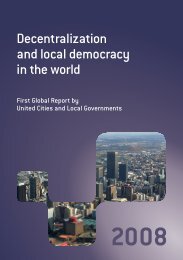Making Cities Resilient Report 2012
Making Cities Resilient Report 2012
Making Cities Resilient Report 2012
Create successful ePaper yourself
Turn your PDF publications into a flip-book with our unique Google optimized e-Paper software.
ANNEXES<br />
CI 2.3. Early warning systems are in place for all major hazards, with outreach to communities.<br />
CI 2.4. National and local risk assessments take account of regional and trans-boundary risks, with a view<br />
to regional cooperation on risk reduction.<br />
HFA Priority for Action 3: Use knowledge, innovation and education to build a culture of safety and resilience<br />
at all levels<br />
CI 3.1. Relevant information on disasters is available and accessible at all levels, to all stakeholders (through<br />
networks, development of information sharing systems, etc.).<br />
CI 3.2. School curricula, education material and relevant trainings include disaster risk reduction and<br />
recovery concepts and practices.<br />
34<br />
35<br />
14<br />
13<br />
27<br />
CI 3.3. Research methods and tools for multi-risk assessments and cost benefit analysis are developed and<br />
strengthened.<br />
CI 3.4. Countrywide public awareness strategy exists to stimulate a culture of disaster resilience, with<br />
outreach to urban and rural communities.<br />
HFA Priority for Action 4: Reduce the underlying risk factors<br />
CI 4.1. Disaster risk reduction is an integral objective of environment-related policies and plans, including for<br />
land use, natural resource management and adaptation to climate change.<br />
CI 4.2. Social development policies and plans are being implemented to reduce the vulnerability of<br />
populations most at risk.<br />
CI 4.3. Economic and productive sectoral policies and plans have been implemented to reduce the<br />
vulnerability of economic activities.<br />
CI 4.4. Planning and management of human settlements incorporate disaster risk reduction elements,<br />
including enforcement of building codes.<br />
HFA Priority for Action 5: Strengthen disaster preparedness for effective response at all levels<br />
CI 5.1. Strong policy, technical and institutional capacities and mechanisms for disaster risk management,<br />
with a disaster risk reduction perspective, are in place.<br />
CI 5.2. Disaster preparedness plans and contingency plans are in place at all administrative levels, and<br />
regular training drills and rehearsals are held to test and develop disaster response programmes.<br />
CI 5.3. Financial reserves and contingency mechanisms are in place to support effective response and<br />
recovery when required.<br />
16, 23, 24, 29, 30, 31<br />
32<br />
7, 8<br />
9<br />
10<br />
17, 18<br />
1<br />
22, 28, 36, 37, 38,<br />
41<br />
33, 39<br />
CI 5.4. Procedures are in place to exchange relevant information during hazard events and disasters, and to<br />
undertake post-event reviews.<br />
<strong>Making</strong> <strong>Cities</strong> <strong>Resilient</strong> <strong>Report</strong> <strong>2012</strong> | 97

















